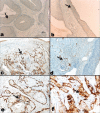The re-awakening of hCG expression. Its role in the diagnosis of cervical squamous cell carcinoma
- PMID: 30251729
- PMCID: PMC6201007
- DOI: 10.15537/smj.2018.9.22710
The re-awakening of hCG expression. Its role in the diagnosis of cervical squamous cell carcinoma
Abstract
Objectives: To compare immunohistochemical detection of Human chorionic gonadotropin (hCG) expression in paraffin embedded tissue of squamous cell carcinomas (SCC) and high grade squamous intraepithelial lesions (HSIL).
Methods: The samples in this retrospective study were obtained from the archives of the Pathology Department at Gaziantep University, Gaziantep, Turkey, over the period from January 2012 to September 2016. The study group consisted of 55 cases of SCC and 45 cases of HSIL. Tissue expression of hCG was detected by specific binding of anti-hCG antibody using an automated immunohistochemistry staining device. The categorical variables of intensity and coverage were analyzed statistically using Pearson Chi-Square test.
Results: High grade squamous cell lesions cases showed weak (84.4%, n=38/45) to no (15.6%, n=7/45) staining for hCG. None of the HSIL cases showed strong positivity. Strong positivity for hCG was detected in 90.9% (n=50/55) of SCC cases.
Conclusion: Our study supports the association of ectopic hCG expression in cancer pathogenesis by demonstrating strong hCG immunoreactivity only in SCC cases. This finding can be helpful in supporting the diagnosis of invasive carcinoma in small or fragmented biopsies, which can on their own be confusing for the pathologists.
Figures

Similar articles
-
Frequent expression of beta-human chorionic gonadotropin (beta-hCG) in squamous cell carcinoma of the cervix.Int J Gynecol Pathol. 1999 Oct;18(4):381-6. doi: 10.1097/00004347-199910000-00014. Int J Gynecol Pathol. 1999. PMID: 10542948
-
Combined detection of Twist1, Snail1 and squamous cell carcinoma antigen for the prognostic evaluation of invasion and metastasis in cervical squamous cell carcinoma.Int J Clin Oncol. 2018 Apr;23(2):321-328. doi: 10.1007/s10147-017-1210-2. Epub 2017 Nov 3. Int J Clin Oncol. 2018. PMID: 29101499
-
Comparison of the diagnostic value of cervical cytology and HPV HR DNA testing for the diagnosis of low-grade and high-grade squamous intraepithelial lesions across different age groups.Ginekol Pol. 2017;88(3):141-146. doi: 10.5603/GP.a2017.0027. Ginekol Pol. 2017. PMID: 28397203
-
EpCAM expression in squamous cell carcinoma of the uterine cervix detected by monoclonal antibody to the membrane-proximal part of EpCAM.BMC Cancer. 2017 Dec 4;17(1):811. doi: 10.1186/s12885-017-3798-z. BMC Cancer. 2017. PMID: 29202724 Free PMC article.
-
[Clinical significance of σ1 receptor over-expression in cervical cancer and the effect of its synthetic ligands on the growth of cervical cancer cells].Zhonghua Fu Chan Ke Za Zhi. 2017 Jul 25;52(7):473-482. doi: 10.3760/cma.j.issn.0529-567X.2017.07.008. Zhonghua Fu Chan Ke Za Zhi. 2017. PMID: 28797155 Chinese.
References
-
- Schiffman M, Castle PE, Jeronimo J, Rodriguez AC, Wacholder S. Human papillomavirus and cervical cancer. Lancet. 2007;370:890–907. - PubMed
-
- Iles RK. Ectopic hCGbeta expression by epithelial cancer: malignant behaviour, metastasis and inhibition of tumor cell apoptosis. Mol Cell Endocrinol. 2007;260-262:264–270. - PubMed
MeSH terms
Substances
LinkOut - more resources
Full Text Sources
Other Literature Sources
Medical
Research Materials

